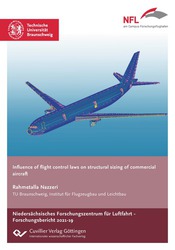| Fachbereiche | |
|---|---|
| Buchreihen (96) |
1378
|
| Nachhaltigkeit |
3
|
| Gesundheitswesen |
1
|
| Geisteswissenschaften |
2364
|
| Naturwissenschaften |
5406
|
| Ingenieurwissenschaften |
1793
|
| Allgemeine Ingenieurwissenschaften | 292 |
| Maschinenbau und Verfahrenstechnik | 862 |
| Elektrotechnik | 686 |
| Bergbau- und Hüttenwesen | 30 |
| Architektur und Bauwesen | 75 |
| Allgemein |
98
|
|
Leitlinien Unfallchirurgie
5. Auflage bestellen |
|
Erweiterte Suche
Influence of flight control laws on structural sizing of commercial aircraft
Rahmetalla Nazzeri (Autor)Vorschau
Leseprobe, PDF (82 KB)
Inhaltsverzeichnis, PDF (33 KB)
The increasing demand for new civil aircraft pushes aircraft manufacturers to develop innovative solutions that lead in particular to mass reductions. One way to achieve these kinds of improvements is the use of multidisciplinary analysis and optimization. In this sense the intention of this PhD thesis is to develop a multidisciplinary framework in order to quantify the impact of load alleviation function parameter changes on structural components like the wing and fuselage in terms of resulting mass changes. The developed iterative process chain covers the loads calculation including an active load alleviation system, a structural assessment of the wing and fuselage components and a dedicated feedback loop in order to update mass and stiffness properties of the loads calculation model. The study shows that significant mass reductions are achievable while on the other hand estimated mass penalties are irrelevant.
Die stetig wachsende Nachfrage an zivilen Verkehrsflugzeugen drängt Flugzeughersteller dazu, innovative Lösungen zu entwickeln. Diese Lösungen zielen speziell auf Kostenträger ab, wie z.B. eine Reduzierung der Flugzeuggesamtmasse. Ein Ansatz, um diese Art von Verbesserungen zu erreichen, ist die Nutzung von multidisziplinärer Analyse und Optimierung. In diesem Sinne besteht die Intention dieser Dissertation darin, eine multidisziplinäre Analyseumgebung zu entwickeln, um den Einfluss von Parametervariationen des Lastabminderungssystems auf Strukturkomponenten wie den Flügel und Rumpf mit Bezug auf resultierende Änderungen der Massen zu quantifizieren. Die hierbei entstehende iterative Prozesskette deckt Disziplinen ab, wie z.B. die Lastenberechnung samt Lastabminderungssystem sowie die strukturmechanische Auswertung der Flügel- sowie Rumpfkomponenten. Zudem ist eine Rückkopplung zur Berücksichtigung von Massen- und Steifigkeitsänderungen im Lastenberechnungsmodell implementiert. Die Studie zeigt, dass eine signifikante Reduzierung der Flügelmasse möglich ist, wobei die geschätzte Massenzunahme am Rumpf vernachlässigbar gering ist.
| ISBN-13 (Printausgabe) | 9783736975163 |
| ISBN-13 (E-Book) | 9783736965164 |
| Buchendformat | A5 |
| Sprache | Englisch |
| Seitenanzahl | 180 |
| Umschlagkaschierung | matt |
| Auflage | 1. |
| Erscheinungsort | Göttingen |
| Promotionsort | Braunschweig |
| Erscheinungsdatum | 15.11.2021 |
| Allgemeine Einordnung | Dissertation |
| Fachbereiche |
Maschinenbau und Verfahrenstechnik
Luft- und Raumfahrttechnik |
| Schlagwörter | load alleviation function, flight control law, manoeuvre load alleviation, structural sizing, commercial aircraft, Airbus, multidisciplinary analysis, simulation framework, sensitivity study, parameter variation, finite element method, manoeuvre, continuous turbulence, flight envelope, loads calculation, vortex lattice method, doublet lattice method, shear moment torque, center of pressure, loads calculation model, beam model, linear static analysis, baseline model, stringer, stiffened panel, wing, fuselage, unitary load case, minimum weight design, fully stressed design, reserve factor, failure criteria, buckling, stiffness matrix, structural mass, internal loads, convex hull, mass increase, equivalent beam, static condensation,Lastabminderungssystem, Flugsteuerungsgesetz, Manöverlastabminderung, Strukturauslegung, Verkehrsflugzeug, Airbus, Multidisziplinäre Analyse, Simulationsumgebung, Sensitivitätsstudie, Parametervariation, Finite Elemente Methode, Manöver, Kontinuierliche Turbulenz, Flugenveloppe, Lastenberechnung, Vortex Lattice Methode, Doublet Lattice Methode, Schub Moment Torsion, Druckschwerpunkt, Lastenberechnungsmodell, Balkenmodell, Lineare statische Analyse, Ausgangsmodell, Stringer, Versteiftes Panel, Flügel, Rumpf, Einheitslast, Gewichtsminimale Struktur, Voll beanspruchte Struktur, Reservefaktor, Versagenskriterien, Beulen, Steifigkeitsmatrix, Strukturmasse, Schnittlasten, Konvexe Hülle, Massenzunahme, Äquivalenter Balken, Statische Kondensation, Strömungsmechanik, Flugsteuerungssystem, Gitterpunktgewichtsgenerator, Bodenschwingungsprüfung, ground vibration test, Schubmoment, shear moment, Auftrieb |








